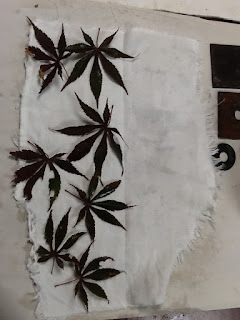After the cooking is done, and eco-printed fabrics have been allowed to rest, then dried, then gently laundered and dried again, and then ironed... what to do with the stash?
Below are the fabrics printed during a two day intensive workshop - yikes!
Some printed pieces can benefit from added colour. For example, the piece below was printed with Japanese maple, then rusted a little. I think that the rust colour is a good complement for the purple-grey.
Ready-made silk scarfs can be purchased on-line, or printed from silk or wool scarfs from thrift stores. These made great gifts and often sell well. Here's an example of a lovely complex print on a light silk scarf.
Although I love the results of eco-printing, I'm still learning about how to use them in finished pieces. I hope that, if you are following this blog, you'll send along your ideas for finishing and using your eco-prints.
I've stitched individual pieces that 'spoke' to me - keeping the stitching relatively simple to (hopefully) enhance the beauty of the print. Here's an example:
I'm beginning to think about whether I could put several eco-printed pieces together to make a large, pieced work - here's one mock-up that I did recently - I add and subtract pieces... auditioning. The pieces are pinned to a piece of foam core - ignore the red, it's the carpet. :
I think that many eco-printed fabrics would make great journal covers. I haven't done much with journals yet. I greatly admire the work that Peta Bailey does with journal covers - see her work at studiopeta.com/blog/
Please, everyone, share your ideas for finishing and using your eco-printed fabrics - I know there are people out there who are doing wonderful things.
Back to Judith... and Judith, I hope that you'll share photos of the eco-printed pieces in your recent show - the stitching was a beautiful complement for each piece.



















































